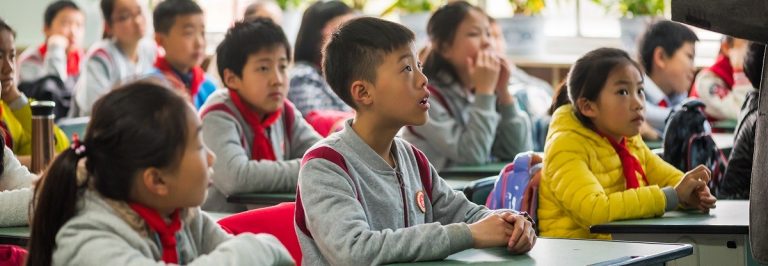
There seems to be a new genre in China’s livestreaming craze: classroom feeds.
While regulators are cracking down on user-generated content – a recent announcement said three online platforms would be banned for broadcasting unsuitable political content – classroom feeds have yet to catch the attention of China’s strict censors.
Thanks (or no thanks) to a recent policy adopted by thousands of classrooms nationwide, students young and younger have inadvertently become the stars of their very own reality TV show. At all hours of the day, parents and any interested netizen can watch livestreams of students as they go about their days, studying, eating, playing and even sleeping.
The purpose of installing these classroom webcams is to encourage better behaviour in both students and teachers alike, but many are railing against the practice, citing concerns about privacy and child safety.
Somewhere, Orwell is crying. Or laughing. In China, Daydreaming Students Are Caught on Camera https://t.co/DThpTuwIQe
— Mei Fong/ 方凤美 (@meifongwriter) April 26, 2017
School officials who advocate the student livestreaming believe it will motivate students to remain mentally engaged on top of being on their best behaviours. After all, their parents may be watching.
Zhao Weifend, director of a private school in Jiangsu province that installed cameras last year, told The New York Times in April: “When you tell them [the students] ‘It’s possible your parents might be behind your back watching’, it’s like a sword hanging over their heads. It makes children behave better.”
This militant approach to China’s education system can, perhaps, be better understood within the context of the country’s exponential economic growth within the last decade.
According to Trading Economics, China’s annual Gross Domestic Product (GDP) growth rate averaged at 9.71 percent from 1989 until this year, which is over triple that of the US’s average growth rate of 3.22 percent, over the same period.
Reports also suggest last year’s slowdown may not continue this year; the world’s second largest economy expanded by 6.9 percent year-on-year in the second quarter of 2017, surpassing market expectations of a 6.8 percent growth and showing promise of a continuing uptick, thanks to retail sales, industrial output and a strong property market.
On top of that, China’s growing wealthy classes generally see education as recession-proof, according to Rahul Choudaha, International Education Researcher and Blogger at DrEducation, meaning the Chinese will continue investing in education to secure their children’s futures.

Thanks (or no thanks) to the livestreaming policy, students young and younger have inadvertently become the stars of their very own reality TV show. Source: Shutterstock
The government also makes it mandatory for all Chinese children to receive at least nine years of basic education, a target it is close to achieving with the Education Ministry reporting at least 99 percent of school-age children today having fulfilled the criteria.
These considerations in mind, it’s no wonder schools are pulling out all the stops to boost student productivity. And what better way to do that than to digitalise the 18th Century concept of Jeremy Bentham’s Panopticon.
Bentham had proposed a prison reform where a watchman’s tower in the centre of the prison meant all inmates could be watched by the guard at any one time. The fear of being caught disobeying orders motivated inmates through paranoia.
In China’s case, the livestreaming of classrooms means not only do students know they could be watched by the guard; they know they are being watched – by anyone, anywhere in the world.
But do the ends really justify the means? And apart from teachers and parents, who else may be tuning in to these livestreams?
There are currently over 200 such livestreams of classrooms from kindergarten to college, accessible around the clock, on streaming website Shuidi Zhibo. On top of privacy concerns, naysayers are questioning the impact the perpetual surveillance may have on students’ mental wellbeing.
One 17-year-old student, Ding Yue, from Yuzhou No.1 High in Xuchang in the Henan Province, told The New York Times: “I hate it. I feel like we are zoo animals.”
Whilst a parent in Henan province told China Global Television Network: “It doesn’t feel safe and leaves no privacy at all. For example, kids have to take off their clothes for their midday nap, and that’s not something for the whole world to gawk at.”
However, some proponents are claiming the practice has its merits and is already showing good result.
Teaching Culture, Ideology and Society in China this semester in China, thankfully no camera in the classroom…http://t.co/eEp3loWiSd
— Tracey Fallon (@FallonTracey) February 1, 2015
According to South China Morning Post, a supervisor at Wuchang University of Technology in Hubei province, told the Chutian Metropolis Daily: “The system has helped us strengthen management, ensure the quality of teaching and shape good learning habits for students.”
Morally justified or not, it looks like these classroom cameras will continue to roll for now.
And with China’s already established culture of livestreaming entertainment, like dating for example, student surveillance is just becoming another genre in the mass-produced people-watching sport.
Liked this? Then you’ll love these…
Design student creates fictional city in disputed South China Sea waters







